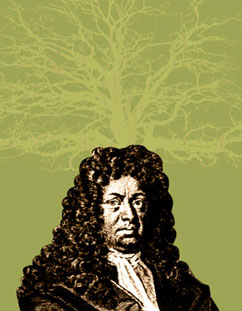 |
| Photo-illustration: Sandbox Studio |
This family tree has physics branches
Who is the grandfather of particle physics? Some might argue he is Otto Mencke, a German philosopher and scientist who received his doctorate from Leipzig University in 1688.
In the SPIRES HEPNAMES database, Mencke has the largest number of traceable academic descendents in the field. His 1228 physicist descendents include 30 at Fermilab, 20 at SLAC, and 19 at Brookhaven National Laboratory.
The worldwide directory of names allows particle physicists and astrophysicists to trace their scientific genealogies in much the same way that people track their family trees. In this case, each senior scientist trains successive waves of graduate students and postdocs, who become siblings of sorts as they work together and go on to train descendents of their own.
John Beacom, a physics professor at Ohio State University, says looking at a colleague's scientific relatives is helpful in understanding his or her school of thought. “There is some family resemblance,” he says. “It's really about understanding the context of who someone is.”
HEPNAMES is part of the SPIRES service, which is jointly operated by DESY, Fermilab, and SLAC. HEPNAMES itself is managed by Fermilab. It gets about 2000 hits per day, mostly from people combing through its 80,000 individual monikers to find current contact information for colleagues, says Heath O'Connell, Fermilab's head of information services.
Enrico Fermi has 27 Fermilab physicists in his family tree, including Winslow Baker, Norman Gelfand, King-Yuen Ng, Jim Strait, and Gong Ping Yeh. Ten Fermilab physicists had Nobel Prize winners as advisors. Jim Strait, project manager for US participation in the Large Hadron Collider, has three Nobel Prize winners in his physics family.
Beacom primarily uses the database to get background on students. “When I'm trying to judge letters of reference, and professors say a student was their best student, I can look up their other students,” says Beacom. HEPNAMES also can help prevent bias in peer review: Beacom makes sure he doesn't send students' papers to their advisors for review, and vice-versa.
Beacom has been using HEPNAMES regularly since SLAC started it in the early 1980s. “It's interesting and fun just to understand how long and how slow the scientific process is,” he says. “What we are doing today resembles what scientists were doing hundreds of years ago.”
Kristine Crane
Click here to download the pdf version of this article.






